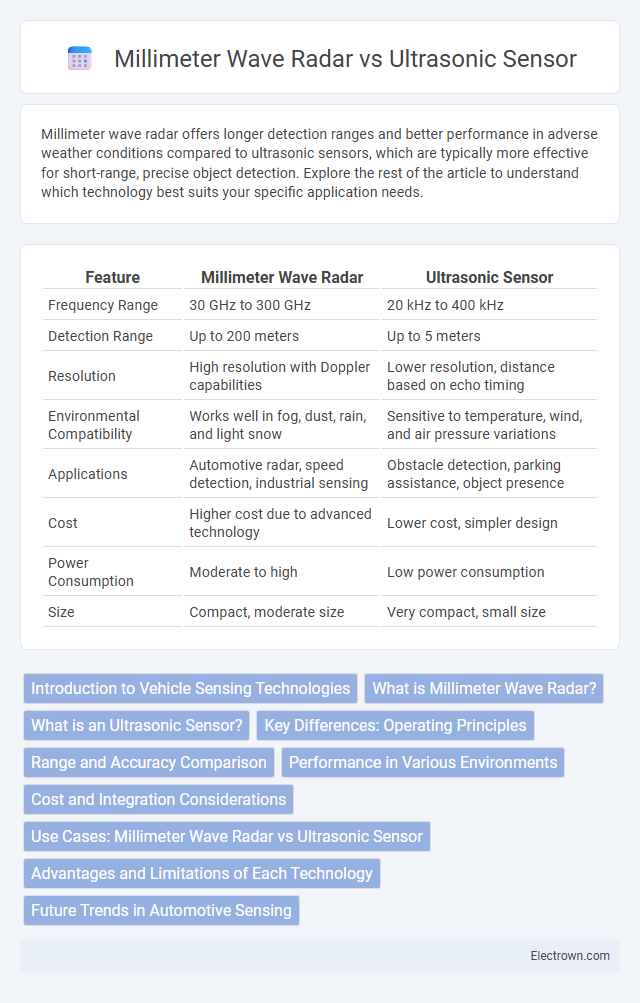Millimeter wave radar offers longer detection ranges and better performance in adverse weather conditions compared to ultrasonic sensors, which are typically more effective for short-range, precise object detection. Explore the rest of the article to understand which technology best suits your specific application needs.
Table of Comparison
| Feature | Millimeter Wave Radar | Ultrasonic Sensor |
|---|---|---|
| Frequency Range | 30 GHz to 300 GHz | 20 kHz to 400 kHz |
| Detection Range | Up to 200 meters | Up to 5 meters |
| Resolution | High resolution with Doppler capabilities | Lower resolution, distance based on echo timing |
| Environmental Compatibility | Works well in fog, dust, rain, and light snow | Sensitive to temperature, wind, and air pressure variations |
| Applications | Automotive radar, speed detection, industrial sensing | Obstacle detection, parking assistance, object presence |
| Cost | Higher cost due to advanced technology | Lower cost, simpler design |
| Power Consumption | Moderate to high | Low power consumption |
| Size | Compact, moderate size | Very compact, small size |
Introduction to Vehicle Sensing Technologies
Millimeter wave radar offers high-frequency electromagnetic wave detection enabling precise vehicle distance and speed measurement under various weather conditions. Ultrasonic sensors utilize sound wave reflections for close-range object detection, ideal for parking and low-speed maneuvering scenarios. Combining these technologies enhances vehicle sensing by providing complementary strengths in range, resolution, and environmental robustness.
What is Millimeter Wave Radar?
Millimeter wave radar operates within the 30 to 300 GHz frequency range, enabling high-resolution detection of objects and precise measurement of distance, velocity, and angle. This technology excels in adverse weather conditions such as fog, rain, and dust, offering superior penetration compared to ultrasonic sensors that rely on sound waves. Millimeter wave radar is widely used in automotive advanced driver-assistance systems (ADAS), industrial automation, and security applications due to its accurate, long-range sensing capabilities.
What is an Ultrasonic Sensor?
An ultrasonic sensor uses high-frequency sound waves to detect objects and measure distances by emitting pulses and analyzing the echo return time. Unlike millimeter wave radar, which operates using electromagnetic waves in the 30-300 GHz range, ultrasonic sensors are ideal for short-range applications, providing precise measurements in environments where radar signals might be affected by materials or weather conditions. Your choice between these sensors depends on factors like detection range, material properties, and environmental resistance.
Key Differences: Operating Principles
Millimeter wave radar uses high-frequency radio waves to detect objects by measuring the time delay and frequency shift of reflected signals, enabling precise distance and velocity calculations. Ultrasonic sensors emit high-frequency sound waves and measure the time it takes for the echo to return, primarily providing distance information. Your choice depends on the application, as millimeter wave radar excels in detecting objects at longer ranges and through adverse conditions, while ultrasonic sensors are better suited for short-range, close-proximity detection tasks.
Range and Accuracy Comparison
Millimeter wave radar offers significantly greater range than ultrasonic sensors, typically detecting objects up to 200 meters away compared to ultrasonic's limited range of around 4-5 meters. Radar provides higher accuracy in detecting object speed and distance, especially in adverse weather conditions, whereas ultrasonic sensors excel in short-range object detection with moderate precision. Your choice depends on application needs: millimeter wave radar suits long-range, high-accuracy environments, while ultrasonic sensors are ideal for close-range, cost-effective solutions.
Performance in Various Environments
Millimeter wave radar demonstrates superior performance in various environmental conditions, including fog, rain, and dust, due to its ability to penetrate these elements and maintain accurate object detection. Ultrasonic sensors excel in short-range applications with clear line-of-sight but experience significant signal attenuation and reduced reliability in adverse weather or cluttered environments. The radar's higher frequency spectrum contributes to longer detection ranges and better resolution, making it preferable for complex or dynamic settings.
Cost and Integration Considerations
Millimeter wave radars typically have higher costs due to advanced semiconductor components and complex signal processing requirements, while ultrasonic sensors are more cost-effective with simpler electronics and lower manufacturing expenses. Integration of millimeter wave radar demands more sophisticated system design and calibration, often requiring specialized hardware and software, whereas ultrasonic sensors offer easier integration with existing systems due to their straightforward operating principles and compact size. Selecting between these technologies involves balancing budget constraints against system complexity and performance needs in applications like automotive safety and industrial automation.
Use Cases: Millimeter Wave Radar vs Ultrasonic Sensor
Millimeter wave radar excels in automotive applications such as adaptive cruise control and collision avoidance due to its ability to detect objects at longer distances and through adverse weather conditions. Ultrasonic sensors are commonly used for short-range obstacle detection in parking assistance and robotic navigation, offering precise measurements in confined spaces. Both technologies complement each other, with millimeter wave radar providing robust detection in challenging environments and ultrasonic sensors ensuring accurate, close-proximity sensing.
Advantages and Limitations of Each Technology
Millimeter wave radar offers high-resolution detection, superior performance in adverse weather, and long-range sensing capabilities, making it ideal for precise object tracking and collision avoidance systems. Ultrasonic sensors provide cost-effective, short-range detection with excellent accuracy for proximity measurement but are limited by environmental factors like temperature and humidity, which can affect their reliability. Your choice depends on the required sensing range, environmental conditions, and budget, as millimeter wave radar excels in complex scenarios while ultrasonic sensors are optimal for simple, close-range applications.
Future Trends in Automotive Sensing
Millimeter wave radar offers superior resolution and long-range detection capabilities compared to ultrasonic sensors, making it essential for the future of autonomous driving and advanced driver-assistance systems (ADAS). Ultrasonic sensors, while cost-effective and reliable for short-range object detection, may be complemented or gradually replaced by millimeter wave technology due to its robustness in diverse weather conditions and complex environments. Your vehicle's safety and automation systems will increasingly rely on the integration of these sensing technologies to enhance accuracy and responsiveness.
Millimeter wave radar vs Ultrasonic sensor Infographic

 electrown.com
electrown.com